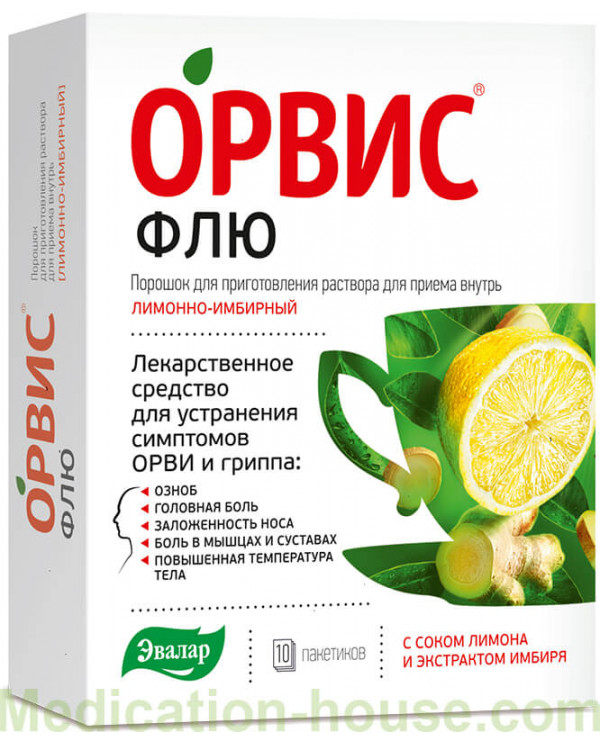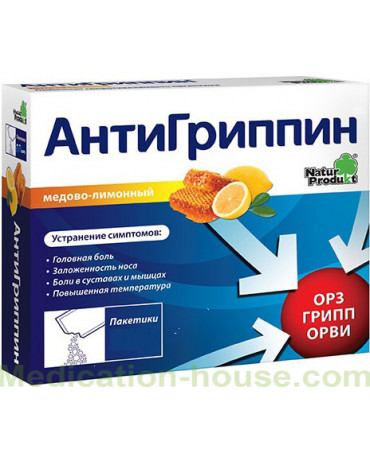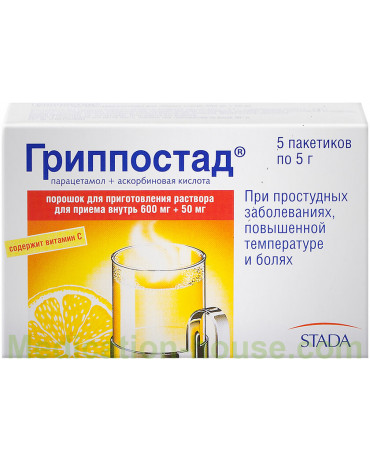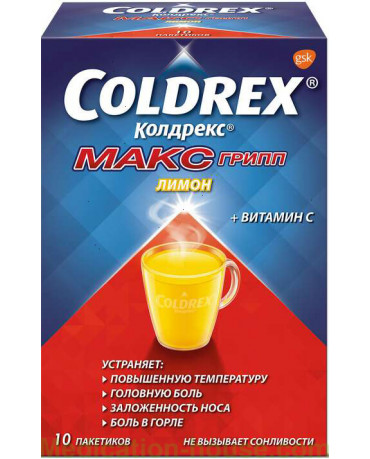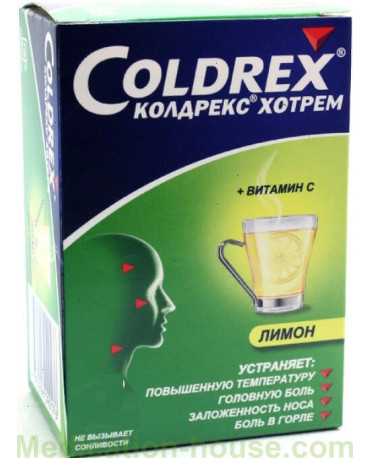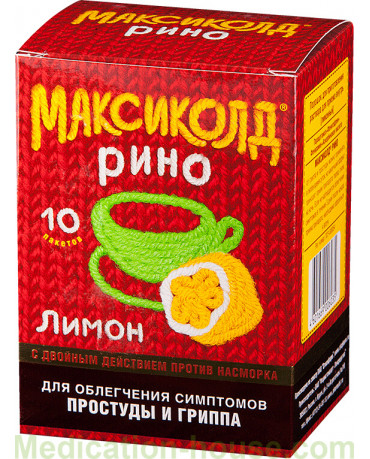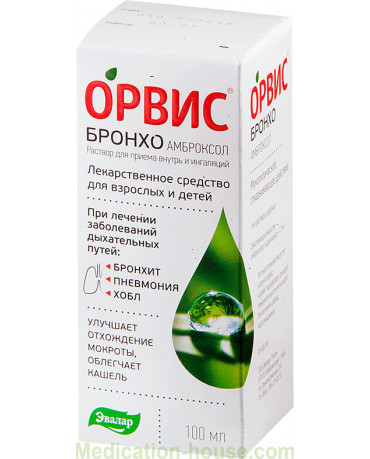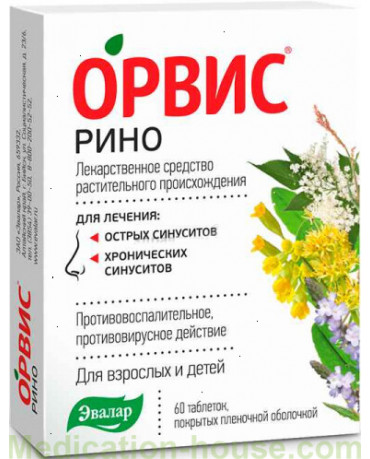Instruction for Orvis Flu
You can buy Orvis Flu here
Orvis Flu Evalar is a symptomatic treatment for acute respiratory infections.
Release form and composition
Dosage form - powder for oral solution (lemon-ginger): granular, may contain easily crumbling lumps, from light pink with a yellowish tint to light brown (blotches of brown, gray and white are possible), with a characteristic odor lemon and ginger; the prepared solution is cloudy, light yellow with a brownish or pinkish tint, with a characteristic smell of lemon and ginger, may contain undissolved particles from yellowish to brown in color (4.95 g each in sachets, in a cardboard bundle 4, 6, 10 or 20 bags and instructions for use Orvis Flu).
Composition Orvis Flu for 1 sachet:
active substances: paracetamol - 500 mg, ascorbic acid - 200 mg, pheniramine maleate - 25 mg;
auxiliary components: dry ginger extract (ginger root extract, maltodextrin, starch, colloidal silicon dioxide), lemon powder concentrate (lemon juice, citric acid, maltodextrin), natural lemon flavor (natural aromatic component, aromatic composition, gum arabic, maltodextrin) , anhydrous citric acid, aspartame, maltodextrin, sodium citrate.
Pharmacodynamics
Orvis Flu is a combined remedy whose action is due to the properties of its active components:
paracetamol is a non-narcotic analgesic that acts on the centers of thermoregulation and pain by blocking cyclooxygenase (mainly in the central nervous system), as a result of which it has an antipyretic and analgesic effect;
ascorbic acid (vitamin C) - is involved in blood coagulation, the regulation of carbohydrate metabolism and redox processes, the synthesis of steroid hormones and tissue regeneration. Reduces vascular permeability, the need for pantothenic and folic acids, vitamins A, B1, B2 and E. It lengthens the action of paracetamol and improves its tolerance;
pheniramine is a blocker of H1-histamine receptors. Eliminates spastic phenomena, hyperemia and swelling of the mucous membrane of the nasal cavity, nasopharynx and sinuses, reduces rhinorrhea and lacrimation.
Pharmacokinetics
After oral administration, paracetamol is rapidly absorbed from the gastrointestinal tract. The maximum plasma concentration reaches within 10-60 minutes. It is quickly distributed throughout the body tissues, penetrates the blood-brain barrier. It binds slightly to plasma proteins, which is of no therapeutic value, however, as the dose increases, the bond increases. It is metabolized in the liver: about 80% of the dose undergoes conjugation with sulfates and glucuronic acid to form inactive metabolites, 17% of the dose undergoes a hydroxylation reaction with the formation of 8 active metabolites, which are subsequently conjugated with glutathione, resulting in the formation of already inactive metabolites. One of the hydroxylated metabolic intermediates exhibits hepatotoxic activity. It is neutralized by conjugation with glutathione, however, it can accumulate in the body and in case of an overdose (150 mg of paracetamol / kg body weight or 10,000 mg of paracetamol inward) cause hepatocyte necrosis. The drug is excreted by the kidneys mainly in the form of metabolites (most of them are conjugates), not more than 5% paracetamol is excreted unchanged. The half-life (T½) is 1-3 hours.
Ascorbic acid, getting into the digestive tract, is absorbed in the small intestine. The maximum plasma concentration reaches within 4 hours. Bioavailability is about 70%. It is metabolized in the liver. It is excreted in the form of metabolites and unchanged by the kidneys, through the intestines and with sweat.
Pheniramine is almost completely absorbed in the gastrointestinal tract. T½ is 1–1.5 hours. It is excreted mainly by the kidneys.
Indications for use
Orvis Flu is used to eliminate and alleviate symptoms such as chills, fever, headache, sneezing, lacrimation, rhinorrhea, nasal congestion, pain in muscles and joints, with the following diseases:
nasopharyngitis;
acute respiratory infections;
acute respiratory viral infections;
flu.
Contraindications
Absolute:
portal hypertension;
liver failure;
erosive and ulcerative lesions of the gastrointestinal tract in the acute phase;
alcoholism;
urinary retention associated with diseases of the prostate gland and impaired urination;
angle-closure glaucoma;
glucose-6-phosphate dehydrogenase enzyme deficiency;
phenylketonuria;
age up to 15 years;
period of pregnancy and lactation;
known hypersensitivity to any component in the composition of Orvis Flu.
Relative (Orvis Flu should be used with caution, after consultation with a doctor):
renal failure [creatinine clearance (CC) <10 ml / min];
viral hepatitis;
alcoholic hepatitis;
congenital hyperbilirubinemia (Rotor, Gilbert and Dubin-Johnson syndromes);
recurrent formation of urate stones in the kidneys;
Chronical bronchitis;
bronchial asthma;
the simultaneous use of drugs with a potentially hepatotoxic effect;
combined use of tricyclic antidepressants;
joint or prior to 2 weeks use of monoamine oxidase inhibitors (MAO);
elderly age.
Application instruction: method and dosage
Orvis Flu powder is taken orally, after dissolving the contents of the packet in 200 ml of hot water (50-60 º), adding sugar if necessary. You can choose any time of day, however, taking the drug before bedtime, at night, is considered more preferable, in which case the greatest effect is noted.
Adults are prescribed 1 sachet 2-3 times a day. The highest permissible dose of Orvis Flu for patients weighing more than 50 kg is 8 sachets per day. However, the interval between doses should not be less than 4 hours, with severe renal impairment (CC <10 ml / min) - 8 hours.
The maximum duration of admission is 5 days. If symptom relief is not observed, fever persists or rises again after the initial decline, you should consult your doctor.
Side effects
When used in recommended doses, Orvis Flu is well tolerated. In some cases, the following side effects are noted:
from the digestive system: dry oral mucosa, abdominal pain, nausea, vomiting, constipation, nephrotoxicity, hepatotoxic effect;
from the nervous system: drowsiness, tremor, impaired coordination, dizziness, insomnia, nervousness, agitation, hallucinations, confusion, impaired attention (more often in elderly patients);
on the part of the organ of vision: impaired accommodation, mydriasis;
from the cardiovascular system: palpitations, orthostatic hypotension;
from the hemopoietic system: anemia, leukopenia, thrombocytopenia, agranulocytosis;
from the genitourinary system: violation of urination;
from the respiratory system: bronchospasm;
from the immune system: acute generalized exanthematous pustulosis, toxic epidermal necrolysis (Lyell syndrome), Stevens-Johnson syndrome;
allergic reactions: skin rash, urticaria, itching, erythema, anaphylactic shock, Quincke's edema.
Overdose
Symptoms of acute paracetamol poisoning: epigastric pain, nausea, vomiting, anorexia, drowsiness, pallor of the skin, increased sweating, metabolic acidosis (including lactic acidosis). An overdose threshold can be lowered in children, the elderly, malnourished patients and patients who drink alcohol and take certain drugs (for example, inducers of microsomal liver enzymes). After 1-2 days, signs of a functional liver disorder appear. In severe cases, liver failure, hepatonecrosis, encephalopathy, coma are possible complications, fraught with death.
Symptoms of pheniramine poisoning: impaired consciousness, convulsions, coma.
In case of taking an excessive dose of Orvis, Flu should rinse the stomach, take enterosorbents (activated charcoal, hydrolysis lignin) and consult a doctor. As an antidote, they are injected intravenously or acetylcysteine is prescribed inside (if possible, in the first 10 hours after an overdose), further treatment is symptomatic.
special instructions
Powder Orvis Flu does not contain sugar, so it can be prescribed for patients with diabetes.
During the treatment period, if possible, the use of other paracetamol-containing preparations should be avoided. In the case of taking such a combination, it must be borne in mind that the total daily dose of paracetamol in all the drugs taken should not exceed 4,000 mg, otherwise an overdose may develop.
To avoid toxic damage, you should refrain from drinking alcohol.
Orvis Flu is not recommended for alcohol abusers. In patients with alcoholic hepatitis, the risk of liver damage increases.
In the case of prolonged use of Orvis Flu and / or in high doses, the development of mental dependence on the drug is possible.
Influence on the ability to drive vehicles and complex mechanisms
In some patients, Orvis Flu causes drowsiness and dizziness, in this regard, it is recommended to refrain from performing work requiring precise reactions and increased attention.
Pregnancy and lactation
No animal studies have been conducted; there is no clinical experience with the use of the combination paracetamol + ascorbic acid + pheniramine during pregnancy. For this reason, Orvis Flu is contraindicated in pregnant women.
Whether the active ingredients of Orvis Flu penetrate into mother's milk is not known. If treatment is required during lactation, women are advised to stop breastfeeding.
Use in childhood
Orvis Flu is not prescribed for children and adolescents under 15 years of age.
With impaired renal function
In severe renal failure (CC <10 ml / min), drug treatment should be carried out with caution.
With impaired liver function
Hepatic failure is a contraindication to the appointment of Orvis Flu.
Use in old age
Elderly patients should be treated with caution.
Drug interaction
Pheniramine enhances the action of the following drugs: sedatives from the group of H1-histamine blockers, antidepressants (amitriptyline, mianserin, mirtazapine), antipsychotics (meprobamate, phenothiazine derivatives), morphine derivatives, barbiturates, benzodiazepine derivatives and other tranquilizers, When using such a combination, the sedative effect increases, the likelihood of side effects, such as dry oral mucosa, urinary retention, and constipation, increases.
Ethanol enhances the sedative effect of pheniramine, contributes to the development of acute pancreatitis.
Paracetamol increases the effect of indirect anticoagulants. Reduces the effect of uricosuric drugs.
The hepatotoxic effect of paracetamol is enhanced by microsomal oxidation inducers: ethanol, rifampicin, phenylbutazone, flumecinol, tricyclic antidepressants, barbiturates, anticonvulsants (phenytoin).
With the simultaneous use of salicylates increase the risk of nephrotoxicity, glucocorticosteroids - the risk of developing glaucoma.
Orvis Flu enhances the toxicity of chloramphenicol (chloramphenicol).
It is possible to increase central atropine-like effects when combined with other drugs with anticholinergic properties, such as phenothiazine antipsychotics, imipramine antidepressants, atropine-like antispasmodics, m-anticholinergic antiparkinsonian drugs, other antihistamines, and disopyramide.
Terms and conditions of storage
Store at a temperature not exceeding 25 ºС out of the reach of children.
Shelf life is 3 years.
Reviews
Patients leave positive feedback about Orvis Flu: the drug quickly and effectively eliminates the symptoms of the common cold, reduces fever, normalizes the general condition. In addition, it is well tolerated, is relatively inexpensive.
The taste of the hot drink is generally rated as pleasant, but some do not like the ginger flavor.
Terms of sel
You can buy Orvis Flu without a prescription.

